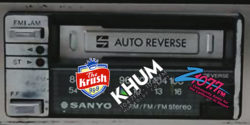While we mostly celebrate non-commercial radio here at Radio Survivor, that doesn’t mean we don’t appreciate commercial radio when done well. The problem is that in the 20 years since the 1996 Telecom Act grossly deregulated radio ownership, the quality of most commercial radio dropped precipitously, leaving many stations with very little local programming, with fewer—or maybe even no—local hosts.
Yet, there are still some truly local commercial stations out there, with real, live air staff who are in touch with a community’s tastes and needs. I was delighted to tune in to a few during a recentlty-completed road trip vacation from Joshua Tree, CA back home to Portland, OR.
Old School Local News in Joshua Tree
At the top of the 9 AM hour on a Friday morning I was treated to about 20 minutes of locally reported news and community updates on Z107.7, KCZD-FM in Joshua Tree. Ostensibly a CHR / Top 40 station, the news report included reports from a variety of correspondents, covering local events and other information of local import. It reminded me of the hourly news I heard on WOBM-FM growing up in Toms River, NJ, reported by local journalists and hosts, detailing the kind of regional stories that would never be heard on the stations coming out of bigger cities to the north and west.
It’s easy to understand why radio is an important lifeline in a community like Joshua Tree, located in the California desert, where cell signals and wifi can be hard to find just a mile off the main road through town. Someone visiting the national park probably won’t get a cell signal, but can still turn on the radio and hear emergency announcements, or just the weather update.
Krushing It in Sonoma
The following week I was treated to local DJs serving up alternative, blues and country-inflected rock while rock I stayed a couple of days in Windsor, CA to tour wineries in nearby Healdsburg. KRSH-FM, The Krush—the name reflecting the area’s wine industry—kept us company as we drove around the region. I was sad to hear the signal fade when we later journeyed north.
I left a few days before the devastating wildfires fires began, and once I arrived home I followed The Krush online. The station broadcast regular news updates until it was forced off the air by the fire, but kept updates going on its website and social media accounts the entire time.
Radio Without Rules in Humboldt
Outside Eureka, as we made our way toward Redwood National and State Parks, a scan of the dial turned up KHUM-FM, Humboldt freeform radio. The station’s motto is “radio without the rules,” and I have to say after listening for a few days, this is more true for KHUM than any commercial radio station I’ve heard in at least a decade.
One afternoon around 2 PM the hour started off with the song “Borneo” from Firewater, an eclectic world-beat influenced band that I love, but honestly have only ever heard on the radio once before (on KEXP, by the way). That was followed by the contemporary swing band Squirrel Nut Zippers and the classic swing artist, Bob Willis and His Texas Playboys.
If I hadn’t known better, I would have thought I was listening to college or community radio. Even many of the DJs had the relaxed, conversational tone you expect on the left end of the dial. But I also heard honest-to-goodness ads, mostly for local businesses, including spots where these business owners testified their support for the station.
Compared to the five-to-seven minute long stop-sets I suffered through while traveling the freeways between Bakersfield and Sonoma County, KHUM’s were refreshingly short, rarely clocking in over 2 minutes. That said, there was a fair amount of repetition, probably reflecting a small inventory of advertisers.
The Advantage of Small
At this point it is fair to recognize that these stations all serve relatively small or rural communities and markets, the kind that are of less interest to behemoths like iHeartMedia or Cumulus. That means big companies are relatively unlikely to buy up competing stations there, consolidating operations and pushing ad rates ever downward.
They also serve communities that seem able and willing to support unique local commercial radio. That’s always the rub with commercial radio – listeners don’t expect to have to donate to keep you on the air, so the local business dollars need to be there. Depending on the local economy, it just might be the case there isn’t sufficient advertising dollars in some small towns.
Nevertheless, it is both refreshing and heartening to stumble into quirky commercial stations that reflect and serve local needs.
Though this piece is about commercial radio, honorable mention goes to community radio KMUD in Humboldt County, which also kept us entertained and informed from just south of Garberville, all the way up past the Oregon border.
Do you know of or listen to a commercial radio station that still provides unique local service? Let us know in the comments.



